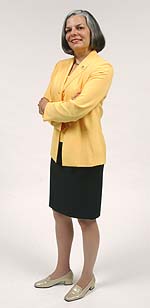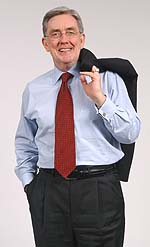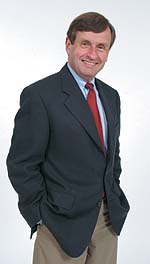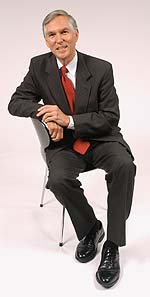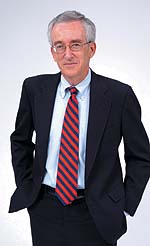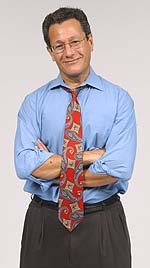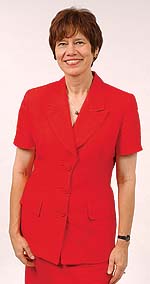|
Partners The decision to relocate to Atlanta was a complex one for the American Cancer Society (ACS). After all, ACS had been founded in New York in 1913 and a fixture of the city for 75 years. The ramifications of moving its headquarters extended far beyond health to economics and politics. Three cities vied to be the new location for the nation’s largest cancer nonprofit, and in the end, New York City submitted its own bid to get ACS to stay. A consulting firm advised ACS leaders that if they moved they’d be lucky to take 25% of current employees with them, and there was another incentive the company would need to offer the pedestrian-bound New Yorkers—driving lessons. “I couldn’t exaggerate how difficult the decision was,” says John Seffrin, CEO of ACS. “But, in my mind, one of the top reasons to come here was the opportunity to be a part of the Clifton Corridor and to partner with Emory and the CDC.” The move marked the beginning of what Seffrin calls a sea change for the organization. “We used to have an unwritten motto: We only go if we’re the show. We were not joiners. We applauded other people working on the tobacco problem, but we did our own thing on tobacco,” he says. That has changed dramatically in the past 10 years, with current collaborations between ACS and government, business, private foundations, academic institutions, and individual businesses. For example, they are partnering with CDC to prevent breast and cervical cancer among poor women. Through the Collaborative Fellows Project, supported by the Woodruff Foundation, they are learning from academic institutions such as the RSPH how to evaluate their programs. They’ve organized the National Dialogue on Cancer, a forum that brings together representatives from the leading cancer organizations in all three sectors to build greater accountability to the war on cancer.
“We’ve transformed the American Cancer Society from a large cancer charity that raised money locally and did a little research into a far more strategic organization. In short, a co-equal partner with the government and for-profit sectors in the fight against cancer,” Seffrin says. “In my opinion, we are now a true player in public health. That happened purposefully and was influenced by our partnerships.” Building partnerships, especially with CDC, also brought CARE to Atlanta, according to President Peter Bell. “CDC’s great strength is scientific and technical expertise,” he says. “We add to that our experience of working in the thick of it with tens of thousands of poor communities. Bringing the two organizations together creates a tremendous opportunity for synergy.” This synergy blankets a seven-mile radius that extends out from Clifton Road and includes some of the nation’s most powerful public health institutions—CDC, ACS, CARE, The Carter Center, the Georgia Division of Public Health, Morehouse School of Medicine, the Task Force for Child Survival and Development, and the Rollins School of Public Health (RSPH). Their missions vary, but what they share is a partnership to solve public health challenges, problems that if tackled alone would prove insurmountable. Small wonder that Dean James Curran routinely refers to Atlanta as “the public health capital of the world.” “When Emory accredited its public health master’s program in 1975 and then founded the School of Public Health in 1990, it did so with the recognition of opportunities for public health in Atlanta,” Curran says. “With the increased internationalization of Atlanta, the leadership of CDC, and the relocation of organizations such as ACS and CARE, the city has become an epicenter for public health.” “These partnerships are vital,” says Michael Johns, executive vice president and head of the Robert W. Woodruff Health Sciences Center, which encompasses RSPH, Emory School of Medicine, and Nell Hodgson Woodruff School of Nursing. “Effective population health promotion and disease prevention require collaboration across disciplines and throughout our communities of interest and expertise. When we combine Emory’s expertise in teaching and research and our commitment to service with the missions of Atlanta’s public health organizations, we can have a measurable impact on the enormous health challenges we face not only locally but also nationally and internationally."
Great minds think alike “By definition, public health is interactive,” says Julie Gerberding, director of the CDC. “Partnerships have been important and remain important because all public health is local. Most of the programs we implement at the CDC are dependent on other agencies at the local level.” Like CDC at the national level, Georgia’s Division of Public Health provides direction, information, and policies at the state level. “Partnerships are fundamental to everything we do, whether it’s working with districts and local health departments or recruiting physicians in practice,” says Kathleen Toomey, director of the division. As a former practicing physician herself, Toomey has been particularly interested in enlisting Georgia doctors as partners to deliver prevention messages and help with front-line disease surveillance. Her office has reached out to collaborate with physicians on asthma, arthritis, and bioterrorism preparedness. It took Toomey breaking her leg recently to let her know she was reaching her target audience. The emergency room doctor who fitted her cast thanked her for the useful information he received from the state about bioterrorism and other public health issues. Partnerships are particularly vital to organizations like The Carter Center and the Task Force for Child Survival and Development, whose staffs use multiple partners to build support for and implement their programs. John Hardman, director of The Carter Center, lists name after name of CDC staff who over the years have worked closely with the center. “Some even come to work here when they retire from CDC,” Hardman says. “And the same is true for the RSPH. Faculty work closely with us, and our staff regularly teach and share experiences from the field.” The Carter Center nominated two of the William H. Foege Fellows in Global Health who are participating in this inaugural year of the fellowship. The Task Force, founded by former CDC and Carter Center Director and RSPH Presidential Distinguished Professor Emeritus William H. Foege, brought together five founding partners, and in its 20 years of existence, its successes have mounted in large part due to collaboration. “We try to bring different worlds together to help change the way public health solves the problems that everyone faces,” says Task Force Executive Director Mark Rosenberg.
The harvest of collective experiences “No one place is going to be able to come to the table with solutions and approaches, with the level of sophistication and complexity that will match the problem of emerging epidemics that are rooted in the choices that people make,” Gavin says. “We have to bring the Emorys of the world and the populations with which they have expertise with the Morehouses of the world to reap the harvest of collective experiences. What drives us at Morehouse is a desire to weave a public health emphasis through what we are trying to do in primary health care.” CARE also has taken on an ambitious goal - to join the international community in reducing extreme poverty in the world by half by the year 2015. To do so, the international organization is working with literally thousands of partners at all levels from United Nations agencies and the governments of developing countries down to individual volunteers and donors. Founded as a response to the threat of famine after World War II, CARE has since enlarged its mission to help reduce, and eventually end, global poverty. A partnership between CARE and CDC is in full bloom with collaborations in sub-Saharan Africa and Latin America. The two organizations have teamed up to prevent the spread of HIV/AIDS, to train government and community leaders in health management, and to improve access to clean water and sanitation. In Kenya, CDC and CARE succeeded in reducing the incidence of diarrhea in children by 90% in targeted communities by treating household water with a simple bleaching technique that costs only 30 cents a month. In four countries in Africa, they are working to prevent HIV/AIDS transmission from mother to child with another low-cost, cutting-edge technique. The RSPH fertilizes the relationship between CARE and CDC. Stan Foster, professor of international health, has chronicled and evaluated the the collaboration between CARE and CDC, making periodic recommendations about how to strengthen it. Other RSPH faculty contribute to research at CARE, including Robert W. Woodruff Chair of International Nutrition Reynaldo Martorell, who helped the organization with a major nutrition program in Central America. RSPH students regularly intern at CARE, and CARE has nominated two public health professionals who are Foege fellows at the school this fall. Bell sits on the RSPH Dean’s Council, participates in educational panels at the school, and lectures in its classrooms, as do other CARE staff members. “There is a well-beaten path between the RSPH and CARE,” Bell says.
Collaboration vs. competition A case in point: In the early 1980s, both WHO and UNICEF were working separately to raise the global immunization levels of children. Both understood the countries they wanted to target. They had tapped the potential donors and separately each organization had raised $35 million for the effort. Still, the immunization gap between US children (80%) and those in developing countries (20%) was staggering. Bill Foege was convinced public health could do better. As executive director of the Task Force in 1984, he rallied WHO and UNICEF to join with the World Bank, the Rockefeller Foundation, and the UN Development Program to see if together they could make a bigger impact. Within a year, the organizations who formed the Task Force had raised more than $100 million for worldwide immunizations, and they repeated that success in the second year. A mere six years later, the partners had raised more than $1 billion, and global immunization levels of children shot up 400% to cover 80% of kids in the developing world and saving approximately 3,000 lives a day. Jim Grant, former executive director of UNICEF, called the push “the largest peacetime mobilization in history.” “Lessons about partnerships have driven our work from the beginning,” says Rosenberg. “Bill Foege taught us that to succeed in public health, you have to be able to build coalitions with a targeted number of key players. Participants who give equal input and have equal representation will take ownership of the problem and creatively find its solution. Unified, they find that insurmountable problems become achievements far exceeding expectations.” That formula also was adopted by The Carter Center, where Foege as executive director took his imprint in 1987. The center tackles issues of health and peace by joining with multiple partners around the world. According to Hardman, named executive director in December 1992, The Carter Center “involves organizations that have the presence, capacity, and resources to deliver the programs in the area we’ve targeted. We don’t duplicate efforts. If you want to accomplish the ultimate good, you move to the organization with the greatest strength. The object is not which organization gets the credit but rather controlling or eradicating the disease.” Take the control of onchocerciasis, or river blindness, as one example of a seamless partnership. Carried by black flies that breed in rivers and streams, the disease releases millions of microscopic worms into the body, causing incessant and debilitating itching. When the worms enter the eyes, they can cause damage, even blindness. Economic and health consequences are devastating: adults cannot farm or care for their children. They abandon fertile riverbanks and move inland for fear of contracting the disease. In 1987, Merck &Co. committed to donate a drug it discovered and developed, Mectizan, for the treatment of river blindness for as long as needed, and Merck asked the Task Force to administer the program. “Many in public health were skeptical of a big pharmaceutical company and thought such an affiliation could taint public health’s reputation,” says Rosenberg, but the Task Force took Merck up on its offer, bringing together a host of additional organizations to help make the drug donation program work. Today the Mectizan Donation Program, as part of the Task Force, oversees the donation for Merck, working with an expert committee for the approval of applications from ministers of health and other partners. The Carter Center works in particular countries and is one of many non-governmental organizations that facilitate the delivery of Mectizan and oversee treatment programs. After 16 years, more than 250 million treatments of Mectizan have been delivered, bringing the disease under control in many areas of Africa and most of Latin America and transforming villages. People are returning to farm the fertile lands by many African rivers, restoring health and economic vitality to regions previously abandoned. Partnerships like these work best, of course, when turf matters less than results. Collaborations between the Georgia Division of Public Health and RSPH fit that description. In working with the RSPH, Toomey says it matters little who gets credit. “If you need to take credit, partnerships are not the way to go.” The state’s recent collaborations with RSPH include development of training materials for Georgia’s public health workforce and a web-based assessment tool. On a recent educational CD-ROM on smallpox, the state provided the content material, and RSPH provided multimedia and design input. This year the Division of Public Health staff and RSPH faculty delivered a statewide training series for community physicians on emergency responses to terrorist threats. They worked together to develop the curriculum and prepare the syllabus, and Emory’s direct funding for bioterrorism training helped the state leverage a resource for preparing its workforce for emergencies. The RSPH and the Georgia Division of Public Health are “philosophically united in our vision to work together to improve Georgia’s public health system,” says Toomey. “I can’t imagine doing my job without the RSPH.” This close collaboration is rare among state public health practitioners and academics, says Toomey, who recently discussed the relationship between the Georgia Division of Public Health and RSPH at a meeting of the Association of State and Territorial Health Officials. “When they heard how closely we were working together, people were astonished,” she says. She hopes that Georgia will serve as a model for how other state public health departments might develop integral working partnerships with local universities.
For better or worse Collaboration does bring its challenges. Partnerships take time and energy. The process requires a clearly focused strategy, a structure that designates how the work will get done, how the partnership will be organized, who will pay for what. Then one organization needs to be designated to take the lead in the daily management of a coalition made up of individual organizations, each with their own culture. “Many of the public health institutions in Atlanta are large with very distinct, detail-oriented missions,” says Curran. In successful partnering, he says, the devil is in the details. Rosenberg compares these complex relationships to a marriage: “It is easy to form a coalition but hard to make it work,” he says. “Members of coalitions are already busy, and usually coalition activities are not a part of their ‘day job.’ Therefore, you have to pay special attention to the partners and the process.” A psychiatrist by training, he believes one underemphasized but vital part of that process is understanding how social capital affects partnering. “The coalition won’t work if the people in it don’t like working with each other and don’t want to work with each other.” Although collaborations take time, in the end they save time, says Gerberding. “I can name many examples where we move more quickly and powerfully because of partnerships. They create a synergy, overlapping the strengths in individual organizations.” That has certainly happened in Atlanta. In fact, a newly organized Atlanta Coalition for Global Health has brought together many of these partners to work together on specific charters. One of the coalition’s first efforts is to work with WHO to help transform the organization from one that simply sets standards to one that implements programs through partnerships.
A leg up “I call it that,” says Hardman. “So does Dean Curran. So, I hope, so do the other public health leaders here. After all, any number of the organizations that are in Atlanta could as easily be in Washington or New York. By being here, they draw people’s attention to Atlanta.” Bell, who was on CARE’s board of directors when the organization was still located in New York, remembers the difficulty in building relationships with other public health-oriented institutions there. “The city was almost too big and complex,” he says. By contrast, proximity in Atlanta encourages the logistics required for partnerships. “There is a shared sense among the leaders of our diverse public health institutions that we can strengthen one another,” Bell says. Gavin explains it like this: “Atlanta is a relationship town. As people get to know people, then programs at other institutions, an integration begins to happen. There is an ease of exchange not just among the leaders but also among the staffs and students as they get exposure to what the others are doing. Opportunities for new insights are sparked when we are meeting and greeting, eating and drinking, attending lectures and discussing programs with each other. This is a remarkable place for forming and maintaining partnerships. We have a leg up if we can maximize it.” By Rhonda Mullen
G-Training in Progress | Resisting Superbugs | Foege Fellows | Cancer Collaboration | County Connections | Class Notes & Alumni News | Rollins School of Public Health
Copyright © Emory University, 2003. All Rights
Reserved. |
